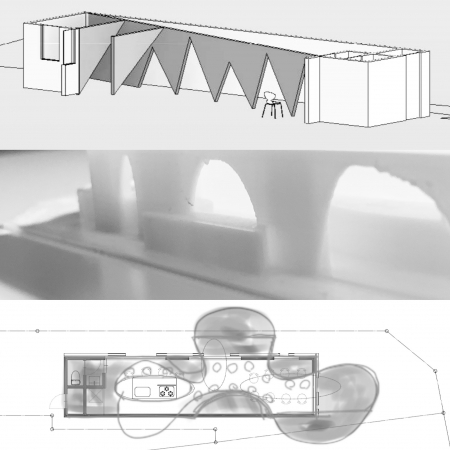窓が無い外観
外観に開口部、いわゆる窓の大きさと位置をランダムにして設置することはすでにスタンダードになった。窓の大きさや位置からプランが推測できたり、窓が室内の特定の様子を映し出したり、逆に室内から特定の風景を良く見せたりなどの、窓に窓以外の意味を持たせないためにランダムに行うのだろう。あと、外観の見た目のデザインした感もあるだろう。
すでに窓をランダムに配置することはひとつの形式になったので、いちいち詮索しない、詳細に見ない、そういうものだと見た目だけで判断してスルーしてしまう。
最近面白いと思うのは、外観がない状態、外壁を剥がし取ってしまい、窓というものの存在感がなく、内部の様子が外部に溢れ出たような見え方をしている状態である。もしかしたら工事途中の状態、あるいは既存の建物の解体工事途中の状態に似ているかもしれない。
窓というものが内部と外部をつなげることを唯一の役目としたならば、窓というフレームで切り取る必要は無く、そもそも窓というもの自体が無くても内部と外部をつなげることはできるはずである。
「窓が無く内部と外部がつながる外観を持つ建築」と言葉で記述してみたが、そこを目指すとして、実現可能かどうか、むしろ矛盾や不明なことを含んだ言葉の方が創造力が働く。
"Appearance without windows"
Random installation of openings, so-called windows, in the exterior has already become a standard. Random because the window has no meaning other than the window, such as the plan can be inferred from the size and position of the window, the window reflects a specific state of the room, and conversely, a specific landscape is shown well from the room. Will do it. Also, there will be a feeling of designing the appearance.
Randomly arranging windows has already become one form, so don't snoop, don't look at it in detail, and just look at it and let it through.
What I find interesting these days is that there is no exterior, the outer wall has been peeled off, there is no presence of a window, and the inside looks like it has overflowed to the outside. Maybe it's in the middle of construction, or similar to the state of an existing building being demolished.
If the sole role of a window is to connect the inside and the outside, there is no need to cut it out with a frame called a window, and it should be possible to connect the inside and the outside without the window itself in the first place.
I tried to describe it in words, "architecture with an exterior that connects the inside and the outside without windows", but when aiming for that, creativity works more in words that include contradictions and uncertainties, whether it is feasible or not. ..


